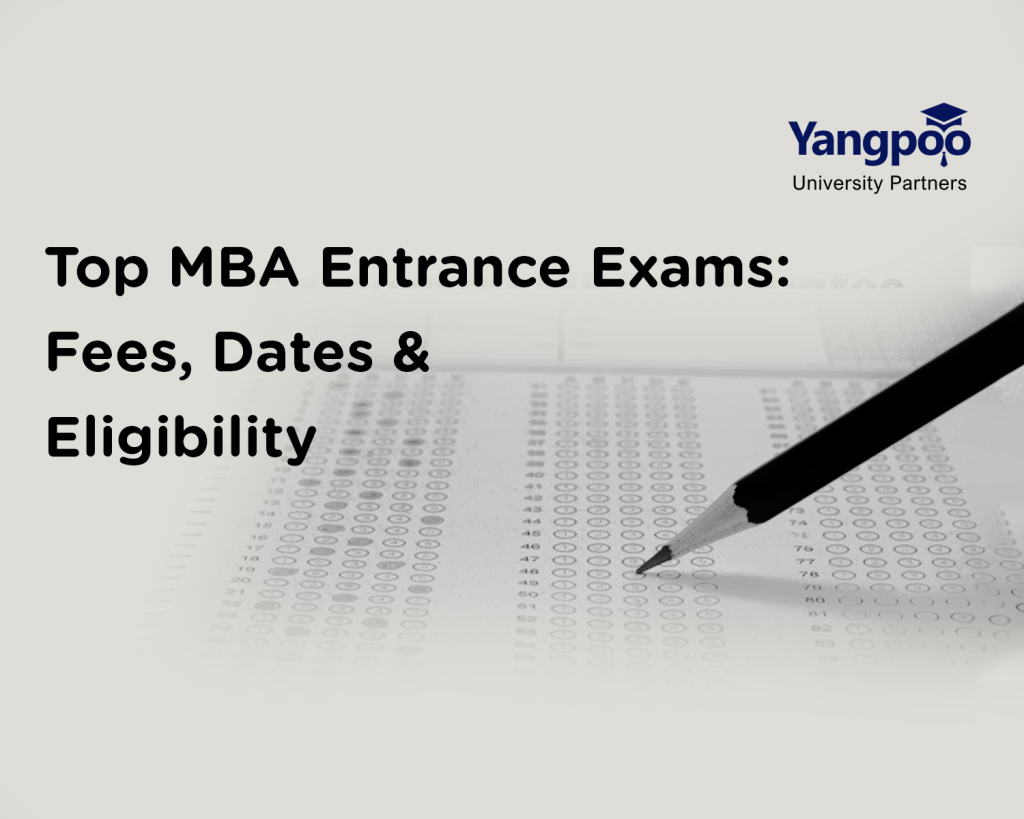Top MBA entrance exams in India serve as gateways to prestigious exams for MBA colleges across the country. These exams evaluate candidates on various parameters such as quantitative ability, verbal skills, logical reasoning, and general awareness. Success in these exams can open doors to leading institutions like the IIMs, XLRI, and other top B-schools, shaping the future of aspiring business leaders. If you’re planning post graduate studies, acing these exams is a crucial step towards achieving your academic and professional goals.
| Exam Name | Duration | Number of Questions | Exam Month |
| CAT | 2 hours | 66 | November |
| GMAT | 3 hours 7 minutes | 80 | Year-round |
| XAT | 3 hours 10 minutes | 100 | January |
| SNAP | 1 hour | 60 | December |
| MAT | 2 hours 30 minutes | 200 | February, May, September, December |
| NMAT | 2 hours | 108 | October-December |
| CMAT | 3 hours | 100 | January-February |
About the Top MBA Entrance Exams –
1. CAT (Common Admission Test)
- Conducting Body: Indian Institutes of Management (IIMs)
- Purpose: CAT is the most popular MBA entrance exam in India and is a prerequisite for admission to the IIMs and many other top B-schools.
- Structure: The exam consists of three sections: Verbal Ability and Reading Comprehension (VARC), Data Interpretation and Logical Reasoning (DILR), and Quantitative Ability (QA).
- Duration: 2 hours
- Scoring: CAT is scored on a scale of 0-300, and the percentile system is used for ranking candidates.
- Exam Month: November
2. XAT (Xavier Aptitude Test)
- Conducting Body: Xavier School of Management (XLRI) Jamshedpur
- Purpose: XAT is used for admission to XLRI and over 150 other B-schools in India.
- Structure: XAT consists of four sections: Verbal and Logical Ability, Decision Making, Quantitative Ability and Data Interpretation, and General Knowledge.
- Duration: 3 hours 10 minutes
- Scoring: The first three sections are considered for percentile calculation, while the General Knowledge section is used during the interview process.
- Exam Month: January
3. NMAT (NMIMS Management Aptitude Test)
- Conducting Body: Graduate Management Admission Council (GMAC)
- Purpose: NMAT is used for admission to NMIMS and other partner institutions.
- Structure: The exam has three sections: Language Skills, Quantitative Skills, and Logical Reasoning.
- Duration: 2 hours
- Scoring: NMAT is scored between 36 and 360, and candidates can retake the exam up to three times within the testing window.
- Exam Month: October-December
4. SNAP (Symbiosis National Aptitude Test)
- Conducting Body: Symbiosis International University (SIU)
- Purpose: SNAP is used for admission to various MBA programs offered by institutes under SIU.
- Structure: The exam consists of General English, Quantitative, Data Interpretation & Data Sufficiency, and Analytical & Logical Reasoning.
- Duration: 1 hour
- Scoring: SNAP has a total of 60 questions, and candidates are awarded 1 mark for each correct answer.
- Exam Month: December
5. MICAT (MICA Admission Test)
- Conducting Body: Mudra Institute of Communications, Ahmedabad (MICA)
- Purpose: MICAT is conducted for admission to MICA’s flagship PGDM-C (Post Graduate Diploma in Management – Communications).
- Structure: The exam is divided into three sections: Psychometric Test, Descriptive Test, and Aptitude Test (which includes Verbal Ability, Quantitative Ability, General Awareness, and Divergent-Convergent Reasoning).
- Duration: 2 hours 45 minutes
- Scoring: MICAT scores are combined with CAT/XAT/GMAT scores for the final selection.
- Exam Month: December (MICAT I), January (MICAT II)
6. MAH MBA CET (Maharashtra Common Entrance Test)
- Conducting Body: State Common Entrance Test Cell, Maharashtra
- Purpose: MAH MBA CET is conducted for admission to MBA programs in Maharashtra state’s management colleges.
- Structure: The exam consists of Logical Reasoning, Abstract Reasoning, Quantitative Aptitude, and Verbal Ability/Reading Comprehension.
- Duration: 2 hours 30 minutes
- Scoring: The test is scored out of 200, with 1 mark awarded for each correct answer.
- Exam Month: March
7. CMAT (Common Management Admission Test)
- Conducting Body: National Testing Agency (NTA)
- Purpose: CMAT is a national-level entrance exam for MBA programs across AICTE-approved institutions.
- Structure: CMAT consists of Quantitative Techniques & Data Interpretation, Logical Reasoning, Language Comprehension, General Awareness, and Innovation & Entrepreneurship (optional).
- Duration: 3 hours
- Scoring: Each correct answer is awarded 4 marks, and 1 mark is deducted for every wrong answer.
- Exam Month: January-February
8. TANCET (Tamil Nadu Common Entrance Test)
- Conducting Body: Anna University
- Purpose: TANCET is conducted for admission to MBA, MCA, and other postgraduate programs in Tamil Nadu’s colleges.
- Structure: The exam includes sections on Business Analysis, Reading Comprehension & Verbal Ability, Quantitative Ability, Data Sufficiency, and General English.
- Duration: 2 hours
- Scoring: TANCET is scored out of 100, with no negative marking.
- Exam Month: March
9. CUET PG (Common University Entrance Test – Postgraduate)
- Conducting Body: National Testing Agency (NTA)
- Purpose: CUET PG is conducted for admission to postgraduate programs, including MBA, in central and state universities across India.
- Structure: The exam includes subject-specific questions along with General Knowledge, Language Comprehension, and Analytical Skills sections, depending on the course applied for.
- Duration: 2 hours
- Scoring: The test is scored out of 400, with varying marking schemes depending on the subject.
- Exam Month: June
These top MBA entrance exams are gateways to some of the best MBA programs in India, each with its own unique structure and selection criteria.
In conclusion, India’s top MBA entrance exams like CAT, XAT, NMAT, SNAP, and others serve as critical pathways to prestigious business schools across the country. Each exam has its unique structure, focus areas, and scoring methods, catering to diverse aspirant profiles. Success in these exams opens doors to esteemed institutions, shaping future business leaders. Therefore, understanding the nuances of each exam and aligning them with your strengths and career goals is essential for securing a place in a top-tier MBA program.
FAQs
Which MBA entrance exam is best?
The best entrance exam for MBA depends on your target schools and career goals. CAT is ideal for top IIMs, XAT for XLRI, and NMAT for NMIMS. Research each exam’s focus and choose based on where you want to study and your strengths.
Which is the easiest MBA exam to crack?
There is no definitive “easiest” MBA exam, as difficulty varies based on individual strengths and preparation. Generally, exams like NMAT and CMAT are considered less intensive compared to others like CAT or XAT due to their simpler format and less competitive nature.
Can I join a MBA without an entrance exam?
Yes, some MBA programs offer admissions without entrance exams based on academic performance, work experience, or interviews. However, most top-tier programs require entrance exam scores.
Is MBA tough to clear?
Clearing an MBA entrance exam can be challenging due to the competitive nature and diverse skill requirements. However, with thorough preparation, practice, and a strategic approach, it is certainly achievable.
Is 70% good in MBA?
A 70% score in an MBA program is generally considered good and reflects a solid understanding of the coursework. However, the significance can vary depending on the institution’s grading criteria and industry expectations.
Does 12 marks matter in MBA?
In MBA admissions, a 12th-grade mark is less critical than your entrance exam scores, work experience, and overall profile. However, it can still play a role in some programs’ eligibility criteria and overall assessment.
Other MBA Degrees from Top Universities at Yangpoo
At Yangpoo, we connect you with top universities offering world-class MBA programs. Explore diverse specializations, gain global exposure, and take your career to the next level with an MBA from prestigious institutions. Enrol & check now for other top programs at yangpoo.





